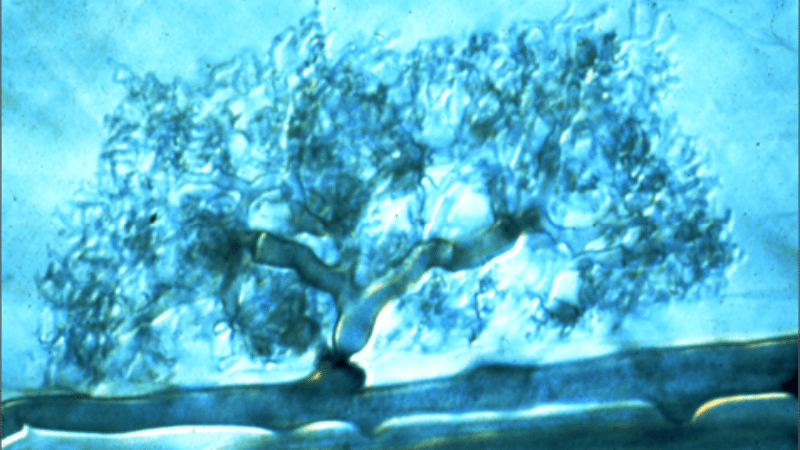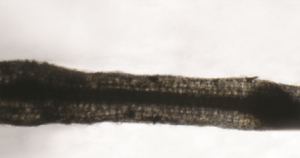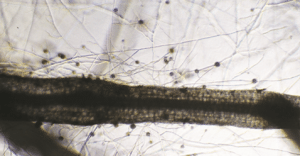
Mycorrhizae: Description of Types, Benefits and Uses
Over the past several decades, a strong interest has developed in the identification and culture of beneficial soil organisms. It is documented that many bacteria and fungi can help plants in combating diseases, locate nutrients and acquire water when in short supply. Within the beneficial organisms exists a complex group of fungi called mycorrhizae (Figure 3, page 20). These fungi grow in association with most plants and have been investigated as growth and quality enhancers for agriculture and horticulture crops.
Most mineral soils contain mycorrhizal fungi, but often at levels that are too low for adequate colonization, especially in disturbed soils (tilled fields, gardens, landscapes, new housing, etc.). Mycorrhizae are host specific and will only colonize certain plants; so in some soils, there are no native mycorrhizae that will benefit these plants. Therefore, most plants would benefit from mycorrhizae addition to the soil.

cell containing
an arbuscule (little tree) endomycorrhizal structure.
Figure 2 (bottom). Magnification of vesicles (round balloon-like structures) found between plant root cells.
Greenhouse crops are grown mostly in soilless media which consists of a base of peat moss, bark and/or coir. These organic components along with the growing medium they compose do not have mycorrhizal fungi strains that would benefit the crops grown in them, so they must be incorporated.
What are Mychorrhizae?
Mycorrhiza (singular), a term that means “fungus root,” describes the mutually beneficial, symbiotic relationship between fungi and plant roots. Symbiosis begins when fungal spores germinate and emerging threadlike structures, called hyphae, enter the epidermis of plant roots. After colonization of the root, the fungus sends out a vast network of hyphae throughout the soil to form a greatly enhanced absorptive surface area. This results in improved nutrient acquisition and uptake by plant roots, particularly elemental phosphorus (P), zinc (Zn), manganese (Mn) and copper (Cu) and water. In return, the plant provides carbohydrates for the fungi. There are more than 150 species of mycorrhizal fungi found around the world in all types of soils and climates. There are several general classes to categorize mycorrhizal fungi; however, the two most common classes are called ectomycorrhiza and endomycorrhiza.
What is the Difference?
Classification of mycorrhizal fungi is based on the inter-relation of the fungal hyphae and plant root cells. Ectomycorrhiza form a compact mantel of hyphae on the outer surface of plant roots, but do not penetrate plant root cells. However, hyphal strands penetrate the root surface and grow between cortical root cells and then extend outward from the mantle to soil surface. Ectomycorrhiza commonly occur on pine (Pinaceae) and most other conifers, birch (Betulaceae), beech and oak (Fagaceae) families and other woody plants. Due to their host range, ectomycorrhizae only provide benefits for forestry seedlings and woody ornamentals.
Endomycorrhizae form an association in which the hyphae penetrate and colonize epidermal and fleshy cortical cells of plant roots. Unlike ectomycorrhizae that produce a surface mantel of hyphae, endomycorrhizae are only present on root surfaces as individual threads. Once the roots are colonized, individual hyphae extend from the root surface outward into the surrounding soil forming a vast hyphal network that absorbs nutrients and water that would otherwise be unavailable to the plant’s root system. Endomycorrhizae can occur on most seed bearing plants (except those colonized by ectomycorrhizae), rain-forest tree species, most agriculture crops and a vast variety of ornamental greenhouse crops. In fact, about 85 percent of the plant families in the world are colonized by endomycorrhizae. The wide range of host plants colonized by endomycorrhizae presents the greatest application and benefits for ornamental horticulture industry. Because of this, endomycorrhizae will be discussed in further detail.
Endomycorrhizal Structures
The most common type of endomycorrhizae is arbuscular endomycorrhizae. They are named based on the structures they produce, arbuscules and vesicles.
- Arbuscules. Colonization of roots begins by the secretion of enzymes by arbuscular endomycorrhizae allowing hyphae to penetrate the epidermal and fleshy cortical cells of plant roots. Two to three days after colonizing the cell, the hyphae form structures within plant cells called arbuscules (Latin for tree) which resemble tiny trees and serve to facilitate the transfer of nutrients within the cortical cells (Figure 1). Arbuscular endomycorrhizae provide the plant with certain fertilizer elements and water from the soil, and in turn, the plant provides sugars and other carbohydrates for the fungus.
- Vesicles. Between the cells, sac like structures, called vesicles (means little sac), form midway or at the terminal ends of the hyphae (Figure 2). Vesicles contain lipids and serve primarily as storage organs for the fungus. Vesicles can also serve as propagules that can colonize other parts of the plant root.
- Spores. Arbuscular endomycorrhizae hyphae also will give rise to spores, which serve the same function as seeds do to plants. Spores have very thick walls, which makes them very resistant to freezing and intense heat so they can survive for long periods of time. For this reason, spores are ideal for incorporating into growing media and for use as inoculants.
It takes two to six weeks for arbuscular endomycorrhizae fungi to completely colonize plant roots and will remain with the plant throughout its life.

Benefits for the Grower and the End User
Intensely farmed land, new housing developments where the topsoil has been stripped away, landfills and mine sites can benefit greatly from endomycorrhizal fungi since the combination of chemical fertilizer applications and the lack of organic matter replenishment has left much of our soils almost void of beneficial organisms. Endomycorrhizae also benefit plants when used in conjunction with phosphorus-fixing soils (sandy soils) and poor-quality soils.
On the other hand, plants grown in average or fertile soils will see benefits from endomycorrhizae when plants are subjected to stressful growing environments (i.e., arid conditions, unseasonal temperatures, low nutrient soils, excessive fertilizer, transplanting shock, establishment of new plantings).
Grower benefits. Growers who use soilless growing media that contain endomycorrhizae typically cater to the fertility and watering needs of the plant and therefore see fewer benefits. However, if any type of stress impacts the crop, endomycorrhizae will help the plant endure the stress and delay any symptoms that come with the stress. These benefits include:
- Reduced nutritional deficiencies. Endomycorrhizae mine out the growing medium to efficiently bring nutrients (particularly phosphorus, copper, manganese and zinc) to the plant where plant roots are not present. This delays nutrient deficiencies and their visual symptoms from appearing.
- Potential reduction in fertilizer use. Since endomycorrhizae mine out the growing medium for fertilizer elements, it is possible to reduce fertilizer application rates.
- Delayed wilting. Endomycorrhizae acquire water from the growing medium where plant roots may not access it, which delays wilting from water stress.
- Improved growth. Efficient acquisition of nutrients helps the plant maintain its optimal growing rate longer, so top growth and root growth are not compromised.
- Resistance to salt toxicity. Endomycorrhizae fungi have been found to protect plants from high salt and micronutrient toxicities.
- Reduced root disease attack. Endomycorrhizal fungi help to reduce the effects of stress on plants, making them less susceptible to attack by root rot pathogens. Not only do endomycorrhizae serve as competition to root rot pathogens by being present on plant roots and consuming root exudates (such as carbohydrates), but they cause the cell walls of the cortex to thicken, making pathogen penetration more difficult.
End user benefits. The homeowner and landscaper have more variables when growing plants outdoors including weather, watering, fertilization and soil quality. These variables can introduce the potential for greater plant stress and therefore have greater benefits from endomycorrhizal fungi. Endomycorrhizae can be incorporated directly into the soil, but if the plant is colonized in the growing medium, the roots will continue to be colonized even after transplanting into the soil. The benefits seen by the landscaper and homeowner are the same as those potentially seen by the grower, but also include the following:
- Resistance to transplant shock. Endomycorrhizal fungi establish quickly in new soil environments, unlike roots. Therefore they can ease transplant shock by providing water and nutrients for the plant and serve as a buffer to help the plant adjust to its new soil environment.
- Increased fruit and flowers. Since plants grow at their optimum rate with endomycorrhizae as a result of reduced stress effects, edibles have the ability and resources to produce more vegetables/fruit per plant and or larger vegetables/fruit. Flowering plants often produce more flowers. Overall plants are often larger when grown with endomycorrhizal fungi, especially if plants are grown in poor quality, low fertility soils.
Summary
Endomycorrhizae assist plants by enhancing plant nutrient and water uptake, reducing environmental stresses and improve the overall growth of plants. Numerous studies have demonstrated benefits for plants used for land reclamation, landscape installations, home gardening, farmers of fruit and vegetable crops, and growers of greenhouse/nursery crops. These benefits can improve efficiencies in plant production and reduce plant production costs for growers.



 Video Library
Video Library 




















